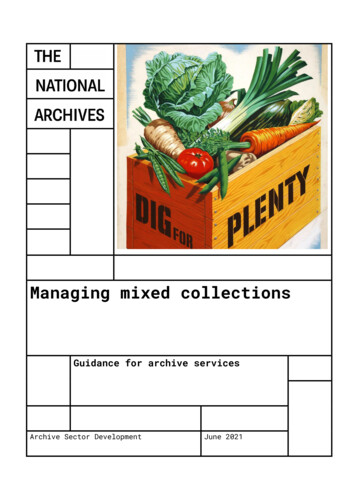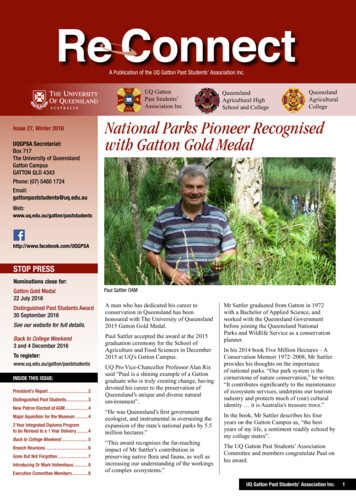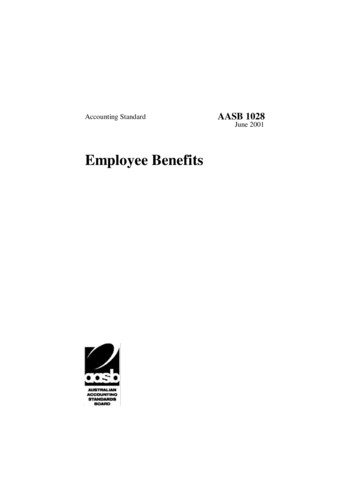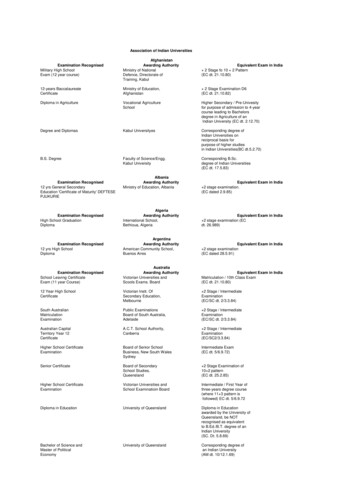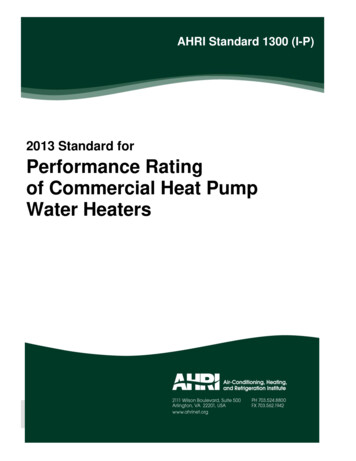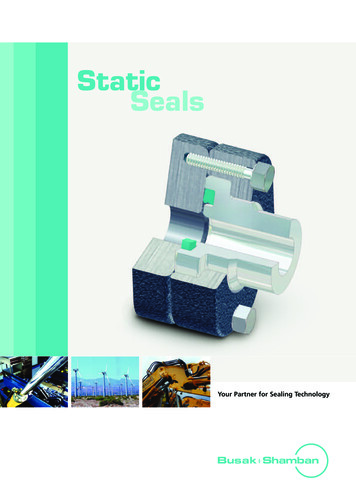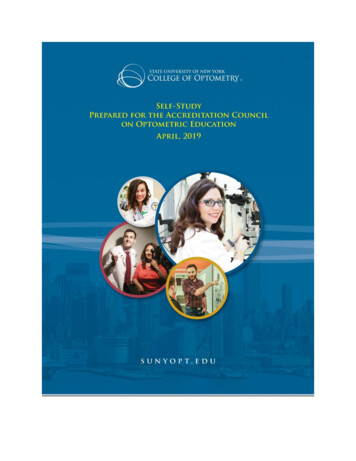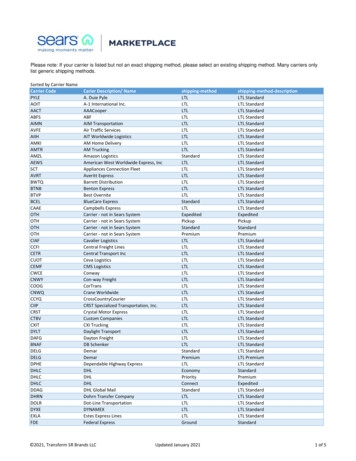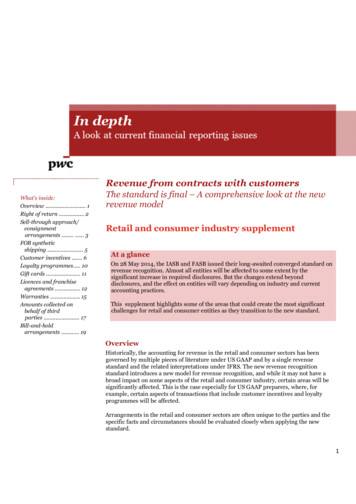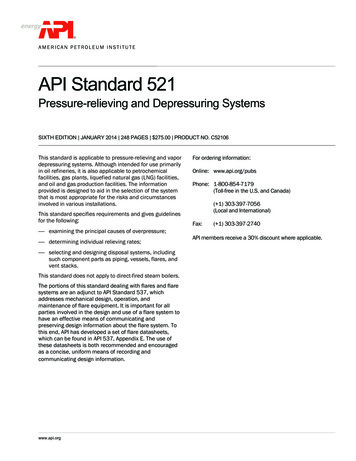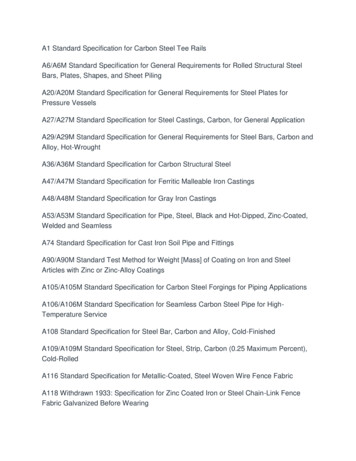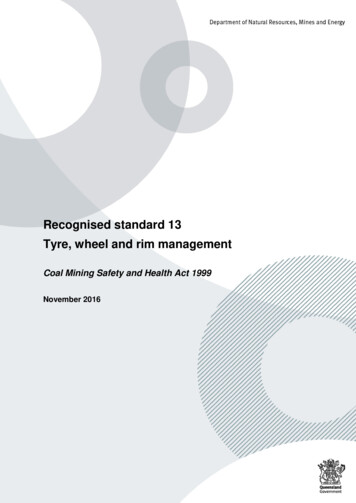
Transcription
Recognised standard 13Tyre, wheel and rim managementCoal Mining Safety and Health Act 1999November 2016
This publication has been compiled by Department of Natural Resources, Mines and Water State of Queensland, 2015The Queensland Government supports and encourages the dissemination and exchange of its information. The copyright inthis publication is licensed under a Creative Commons Attribution 3.0 Australia (CC BY) licence.Under this licence you are free, without having to seek our permission, to use this publication in accordance with the licenceterms.You must keep intact the copyright notice and attribute the State of Queensland as the source of the publication.Note: Some content in this publication may have different licence terms as indicated.For more information on this licence, visit .enThe information contained herein is subject to change without notice. The Queensland Government shall not be liable fortechnical or other errors or omissions contained herein. The reader/user accepts all risks and responsibility for losses,damages, costs and other consequences resulting directly or indirectly from using this information.
Recognised standardsThis document is issued in accordance with Part 5 — Recognised standards and Section 37 (3) of theCoal Mining Safety and Health Act 1999.Part 5 – Recognised standards71 Purpose of recognised standardsA standard may be made for safety and health (a “recognised standard”) stating ways to achievean acceptable level of risk to persons arising out of coal mining operations.72 Recognised standards(1) The Minister may make recognised standards.(2) The Minister must notify the making of a recognised standard by gazette notice.(3) The chief executive must keep a copy of each recognised standard and any documentapplied, adopted or incorporated by the recognised standard available for inspection, withoutcharge, during normal business hours at each department office dealing with safety andhealth.(4) The chief executive, on payment by a person of a reasonable fee decided by the chiefexecutive, must give a copy of a recognised standard to the person.73 Use of recognised standards in proceedingsA recognised standard is admissible in evidence in a proceeding if—(a)the proceeding relates to a contravention of a safety and health obligation imposed on aperson under part 3; and(b)it is claimed that the person contravened the obligation by failing to achieve an acceptablelevel of risk; and(c)the recognised standard is about achieving an acceptable level of risk.Part 3 – Safety and health obligation37.37(3)How obligation can be discharged if regulation or recognised standard made . if a recognised standard states a way or ways of achieving an acceptable level of risk, aperson discharges the person’s safety and health obligation in relation to the risk only by—(a)adopting and following a stated way; or(b)adopting and following another way that achieves a level of risk that is equal to or betterthan the acceptable level.”Where a part of a recognised standard or other normative document referred to therein conflicts withthe Coal Mining Safety and Health Act 1999 or the Coal Mining Safety and Health Regulation 2001, theAct or Regulation takes precedence.This recognised standard is issued under the authority of the Minister for NaturalResources and Mines.Recognised Standards may be updated from time-to-time. To ensure you have the latest versions, referto the Department of Natural Resources and Mines website www.dnrm.qld.gov.au or contact your localInspector of Mines:North RegionPO Box 1752Townsville Qld 4810Ph (07) 4447 9248Fax (07) 4447 9280North RegionPO Box 334Mount Isa Qld 4825Ph (07) 4747 2158Fax (07) 4743 7165South RegionPO Box 1475Coorparoo Qld 4151Ph (07) 3330 4272Fax (07) 3405 5345Central RegionPO Box 3679Red HillRockhampton Qld 4700Ph (07) 4936 0185Fax (07) 4936 4805Central RegionPO Box 1801Mackay Qld 4740Ph (07) 4999 8512Fax (07) 4999 8519Recognised Standard – Tyre, wheel and rim management, Department of Natural Resources and Mines, 2016 iii
Table of contentsRecognised standards. iii1. Purpose . 12. Scope . 13. Application framework . 13.1 Wheels and rims . 13.2 Tyres . 13.3 Associated tools and equipment . 13.4 Exclusions . 14. Technical guidance . 24.1 Tyre, wheel and rim — selection and procurement . 24.2 Receipt and storage of tyres and rims . 54.3 Mounting, demounting, assemble and disassemble . 84.4 Tyre maintenance facility . 124.5 Maintenance and upkeep of tyres, wheels and rims. 144.6 Operation and hazardous conditions management . 164.7 Removal and disposal of tyres, wheels and rims. 194.10 Systems review . 225 Definitions . 236 References . 257 Appendices . 267.1 Appendix 1 Risk assessment outline . 267.2 Appendix 2 Coroner’s recommendations . 27Recognised Standard – Tyre, wheel and rim management, Department of Natural Resources and Mines, 2016 iv
1. PurposeThe purpose of this standard is to give an outline of what elements must be considered in a mine’sSafety and Health Management System (SHMS) and to assist in the development of a StandardOperating Procedure, and other procedures, for the management of tyres, wheels and rims at a coalmine. It provides a managed approach to achieve an acceptable level of risk to persons using theSOP required by Section 72 (a) of the Coal Mining Safety and Health Regulation 2001.72 MiscellaneousA coal mine must have standard operating procedures for the following—(a) fitting, removing, testing, maintaining and repairingtyres and rims on fixed and mobile plant;2. ScopeThis standard applies to all tyres, wheels and rims on mobile, transportable and fixed plant at a mineand includes all associated tools and equipment as mentioned in this standard.Note: Recognised standards are not mandatoryRecognised standards are not mandatory, but when followed provide a way of meeting safety and healthobligations. A person may adopt another way of managing that risk, however in the event of an incident theperson may be required to show that the method adopted was equivalent to the method in the recognisedstandard.3. Application framework3.1 Wheels and rimsThere are many designs of wheels and rims in use at mines - single piece wheels, industrial two pieceand multi piece wheels and rims.3.2 TyresThere many types of tyres in use at a mine, pneumatic tyres (radial and bias construction), filled tyres(polyurethane, rubber insert and water ballasted) and solid tyres.3.3 Associated tools and equipmentEquipment mentioned in this standard that is used for fitting, removing and handling of tyres, wheelsand rims, for example tyre handler, forklift etc.3.4 ExclusionsTyres, wheels and rims that have a proven low risk (such as tyres and wheels or rims fitted to gastrolleys, wheelbarrows, parts trolleys, ride on lawnmowers, and earthmover equipment jacks) areexcluded from this standard.Also tyres, wheels and rims that the mine risk assessment identifies as low risk may be excluded fromthis standard. The controls for all excluded items are to be contained in the mine’s SHMS; thisstandard may be used as guidance material in developing the controls.Note: Risks associated with overpressure, split wheels and plastic wheels fitted to plant such as wheelbarrows or trolleys must be considered.Recognised Standard – Tyre, wheel and rim management, Department of Natural Resources and Mines, 2016 1
4. Technical guidanceThe controls mentioned in this standard will form part of the mine’s SHMS and may be an integral partof the Standard Operating Procedure. The system is to have regard for the guidance given in thissection that covers the life cycle of tyres, wheels and rims from procurement to disposal.Major hazards associated with tyres and wheel or rim components include their physical size, weight,complexity of multi-piece wheels and rims, stored pressure energy, potential for explosion and thedamage resulting from the arduous conditions to which they are subjected. Manual handling ispossible for only a few types of tyre, wheel or rim as most are of a size and weight that necessitatesmachine assistance. Trained personnel are required for work on the wheel and rim assemblies due tothe complexity and critical nature of the work. The consequences of rapid deflation, tyre fire andejection of wheel or rim components have resulted in fatal accidents and serious injuries to mineworkers.Sound tyre and rimmanagement safeproduction4.1 Tyre and rim - selection and procurement4.2 Receipt and storage of tyres and rims4.3 Mounting, demounting, assemble and disassemble4.4 Fit for purpose tyre maintenance facility4.5 Maintenance and upkeep4.6 Operation and hazardous conditions management4.7 Removal and disposal4.8 Information documentation and tracking4.9 Competency4.10 Systems4.1 Tyre, wheel and rim — selection and procurementThe first element in development of a tyre, wheel and rim management system is selection andprocurement of the tyre and wheel or rim. The systematic risk assessment approach requires that thecorrect people are involved, for instance the tyre, wheel and rim manufacturers, mine designers andoperators, tyre, wheel and rim technicians and maintainers and the plant OEM. Data required for therisk assessment is to include: Application:o Earthmoving, large tyres, wheel or rims, light vehicle or fixed planto Will the wheel or rim be a multi-piece, divided (two piece or split rim), single piece ordrop centre?o Will the mounting be cleat mounted or disc mounted?o Will the tyre be for earthmoving, grader, truck, light vehicle or fixed plant? Will it havelugs, tread or smooth?o Is the tyre pneumatic or is there a requirement for solid fill or solid tyres? Solid orsolid fill are generally used for slow moving or occasionally moved equipment(trailers, crib huts).Recognised Standard – Tyre, wheel and rim management, Department of Natural Resources and Mines, 2016 2
ooWhat is the TKPH (earthmoving) or duty cycle required?What are the conditions of operation, type of plant, payload, speed, environmentconditions, equipment utilisation, road gradients and road surfaces?Other considerations at this early stage should include: management of change by the introduction of new tyres, wheels or rims into service (forinstance training of on-site personnel, new style truck)tooling requirements, including tyre handlers, if different from those presently in useunique identifier, branding of tyres, stamping of wheels or rims for tracking and recordkeeping(in protected places on the wheel or rim to retain legibility, also see 4.2.2f) (AS 4457.1 forearthmover wheels and rims)consistency of types of tyres, wheels or rims to provide standardisation on site and reduceconfusionestablishment of a wheel, rim, components and tyre supply guidelines, detailing:o how the wheel, rim, components and tyres are packaged for transport (taking intoconsideration the site’s transport, unload and load procedures)o rim identification nomenclatureo wheel, rim and component colour codingchoice of modern ‘safer’ designs, for instance:o bead seat band designs (for certainty of lock ring correct fitment and retainment)o double gutter rims (for reduction of hazard exposures such as vibration and manualhandling when replacing tyres in duals)o two piece lock rings to eliminate sprung potential energy, minimise manual handlingand line of fire risks (these many also have lock ring retainers, bolted connectors)if the tyres are re-groovable, re-treadable or repairable. Reconditioned tyres should haverepair marks on the sidewall and be tracked in the mine site’s management system (refer AS4457.2, AS 1973)reconditioned tyres may have speed or load restriction and may only be fitted to certainpositions on the plantrepairs on tyres should face the inside of the machinerepaired tyres should not be used as steering tyresintroducing and managing a third party latent risk:o on-site acceptance of wheel and rim components and wheel and rim assemblies,assembled off siteo visitors vehicles and goods delivery to the siteo mobile or fixed plant introduced by contractorsif a dispensation has been given for the application:o where the tyre loading exceeds the manufacturers branding on the sidewall of thetyre, the manufacturer or supplier may raise the load rating by increasing the tyrepressure, restricting the speed of the haul, provide specific training for the operatorsand written instructions for the mine records (applies specifically to earthmovingtrucks and on-road haulage used at mine sites)o ensure wheel or rim rating matches or exceeds tyre load ratingo consider equipment design parameters e.g. wheels or rims and fasteners (studs, nutsand cleats), suspension components, steering.Note: Dispensation in this document refers to the term used in the recommendations made by theCoroner in the Wayne MacDonald inquiry (Appendix 2).Recognised Standard – Tyre, wheel and rim management, Department of Natural Resources and Mines, 2016 3
Image 1: Example of unique identifierImage 2: Earthmover wheel with two-piece lock ringOther items to be supplied to the site include: the OEM or suppliers recommended tyre pressure, wheel or rim fastener torque settings andany dispensation (assists the mine to develop and post a wall chart for relevant personnelinformation)the OEM or suppliers ‘reasons for removal’ of a tyre, wheel or rim (posted wall chart) (AS4457.2 Appendix B has a list of conditions to determine serviceability of earthmover tyres)guidance on management of fasteners (reference manufacturer’s guidance when consideringthe effects of broken or missing fasteners)maintenance requirements during the life of the wheel or rim. (AS 4457.1 has types ofinspection and tests, for earthmover wheels and rims).Recognised Standard – Tyre, wheel and rim management, Department of Natural Resources and Mines, 2016 4
4.2 Receipt and storage of tyres and rims4.2.1 Transportation, receipting, loading, handling and unloadingRisk assessments shall be conducted to identify the controls for transporting and handling:a) Specifically the prevention of injury to personnel or damage to tyres (bead area), wheels andrims (gutter section, grooves and mating surfaces) and assemblies. Appropriate controlsinclude using competent personnel, manual handling techniques, transporting with lock ringfitted and appropriate lifting aids (tyre handler).b) Containerised delivery has its own inherent hazards.c) On highway transport contractors should ensure that consideration is given to other roadusers (transport earthmover tyres vertically reduces the need for wide loads).d) An appropriate inflation pressure for handling and transport of assemblies, mounted on or offthe trucke) Solid and solid fill tyres (polyurethane and inserts) present handling hazards due to theirweight.On receipt of assemblies, where tyres have been fitted off site, conduct a fitment verification check.Check that tyres are at the sites nominated pressure, prior to storage, and verify the competencies ofthe person assembling the wheel or rim assembly.Conduct a similar check of all equipment arriving on site including contractors equipment e.g.introduction to site process, change management, machinery inspection. Tyre, wheel and rim siteregister to be updated: contractors equipment introduced to sitethe wheels and rims that have stamped or branded serial numbers (see 4.2.2 f), priorhistory of tyres, wheels and rims where known.A tyre management and tracking process for tyres, wheels and rims shall be implemented that isfunctional, effective and followed. It shall contain: tyre/wheel/rim details (e.g. TKPH)application (equipment and working environment)pressures, tread history, damage, position, rotation history, hoursNDT historymaintenance records including repair history.Image 3: Vertical transport of tyresRecognised Standard – Tyre, wheel and rim management, Department of Natural Resources and Mines, 2016 5
Image 4: Unloading tyre using fit-for-purpose equipment4.2.2Storage of tyres, wheel and rim and assembliesTyres, wheels and rims should be stored in a safe and clean environment using the controlsdeveloped from a risk assessment. The following points should form part of the risk assessment: Stored:o so that they do not present a hazard and cannot be damaged. Typical hazards couldinclude fire, toppling over, falling off a stack, rolling away and injuring a persono away from traffic to prevent interaction or damageo with adequate working space and adequate lighting for working during hours ofdarkness and easy access for fire-fighting equipmento sidewall information or relevant information chalked or painted on is clearly visibleo in a segregated manner to avoid mismatch and reintroduction of quarantined ordamaged items and to lower the risk of fire hazardsA stock rotation strategy should exist to limit storage time of all components, ‘first in first out’,based on manufacturers recommendations (e.g. rubber products have a ‘use by’ date,corrosion induced cracking)Wheel and rim components should be stamped/branded for ease of identification anddifferentiation between manufacturers, to facilitate selection before fitment and service lifetracking:o stamping should include unique serial number, manufacturing date, repair date, rimstyle, size etc.o stamping in a number of places will aid visibility and legibilityo outward facing when fitted to planto AS4457.1:2007 provides guidance for earthmover wheels and rimsTyres should also be classified by manufacturer, application, retread, reconditioned,quarantined, size, pattern, tread depth and status (for instance new, used, scrap, awaitinginspection)Storage areas shall be free of petroleum products, electrical equipment producing ozone andif possible out of direct sunlightClear signage to identify stored items.Recognised Standard – Tyre, wheel and rim management, Department of Natural Resources and Mines, 2016 6
Storage methodsFor earthmover and large tyres and assemblies AS4457.1 section A10 and AS4457.2 section 2.4provides guidance. Tyres and wheel or rim assemblies should be stored in an appropriate tyre holdingdevice or restrained such that they cannot roll away, topple or be dislodged.When storing large tyres and assemblies horizontally the tyre at the base of the stack may sufferstructural integrity damage to the tyre; they should preferably be stacked no more than three high toreduce the risk of a dislodged tyre toppling or rolling away in an uncontrolled manner. If the stack isrequired to be more than three high, then a risk assessment should take into account factors such as:type of terrain, skill of operators, size of tyres, and capability of tyre handler or forklift.Image 5: Vertical tyre storage showing inspection corridors and segregationTo overcome tyre bead issues, assemblies must be inflated to site storage pressures, as determinedby a risk assessment process, for the size and type of assembly (earthmover tyre typically between20 psi and 30 psi, 140 kPa to 210 kPa) to maintain the bead in the correct seating location on the rimbase. It is recommended that the inflation pressure and date of inflation is written on the tyre sidewallwith permanent crayon.Valve caps shall be fitted to all valve stems to prevent ingress of dirt into the valve stem and provideairtight seal against leakage. Consideration should be given to metal valve caps.Image 5: Large tyre rackingRecognised Standard – Tyre, wheel and rim management, Department of Natural Resources and Mines, 2016 7
Image 6: Wheels, rims and their componentsImage 7: Wheel and rim storage1. Signage shall be in place for all categories of wheel, rim and component storage.2. Stored in designated and clearly identifiable areas in a stable configuration, sorted bymanufacturer, size, lock ring, bead seat profile and common design (single or multi-piece etc.) tosimplify selection of like components and avoid selection of incompatible rim/wheel components.3. Stored off the ground on a compacted well drained area that allows all-weather access for forkliftsand other load shifting equipment, such as tyre handlers.4. Rim components such as bead seat, flange rings and lock rings must be stored in a manner thatretains their serviceability and segregates compatible and incompatible components. Colourcoding reduces the possibility of assembling incompatible components. (Components fromdifferent manufacturers are not necessarily compatible).5. Components waiting for testing or repair shall be clearly marked and stored in a designated andclearly identified ‘quarantine area’ to prevent accidental return to service.6. Damaged, worn-out or unserviceable components shall be rendered inoperable (e.g. by cutting uplock rings) and discarding to a designated area or metal recycling bin.4.3 Mounting, demounting, assemble and disassembleFitting a wheel or rim assembly to a vehicle or plant, assembling wheel or rim components andmounting a tyre to a wheel or rim are tasks that require care and attention to detail. The steps varydepending on the type and size of the tyre, wheel and rim. This section outlines the controls andpoints to consider ensuring mounting, demounting, assembly and disassembly are done correctly andsafely. It is not a step by step guide.During development of the standard a risk assessment was conducted, the outline of the riskassessment is in Appendix 1, it shows the development of the standard and examination of hazardsfor each step. The risk assessment was developed by an industry group specifically for thepreparation of this recognised standard.Recognised Standard – Tyre, wheel and rim management, Department of Natural Resources and Mines, 2016 8
Each vehicle, type of tyre, wheel and rim, application and size (earthmover, large, light truck andpassenger vehicle) presents a different risk profile. For instance, fitting of tyre chains presents aunique set of risks. All activities and procedures must be based on risk assessment principles anddeveloped by a representative group. The safety critical steps and their controls shall be identifiedand highlighted in any developed procedure. For multi piece earthmover applications the safetycritical steps should consider: establishing all components to be reused meet the manufacturer’s component reusabilitycriteria establishing all of the components to be reassembled are compatible components, referenceto manufacturers manual confirmation of correct seating of components prior to partial inflation confirmation of correct seating of components prior to increasing the pressure from partialinflation to full inflation establishing the use of no-go zones to exclude personnel from hazardous areas duringinflation and deflation and the criteria on when access to these areas can be allowed byqualified personnel.The International Council on Mining and Metals (ICMM) has published a critical control managementgood practice guide and a critical control implementation guide (referenced documents section 6).For polyurethane filling of tyres the manufacturer’s process must be followed. The process includespre-stretching of the tyre carcass, pre drilling of the tyre tread area (to allow air to escape as the fillmaterial is injected) and the method of ensuring a complete fill. An incomplete fill will allow the fillmaterial to move during operation of the vehicle and subsequent frictional heating inside the tyre.In a fit for purpose facility (tyre bay)PlanningSome things will exist in the facility (Section 4.4) but should be checked before any maintenancework. They include: fit for purpose hand toolingfit for purpose jacks and stands, OEM nominated jacking and support pointsinflation tool, cagemobile remote inflation/deflation and pressure monitoring abilitymethods showing demarcated zones during inflation (reflective cones, marker tape, paintedhazard areas)calibrated torque tool, pneumatic and manualcurrent chart showing torque for the plant being maintained and re-torque schedulepressure gauges and calibrated master gaugecurrent chart showing the recommended cold inflation pressure for the plant being maintainedtyre handler for large or earthmover tyres, wheels and rims. Fitted with safety devices e.g. fallback arrest arms, relief valves in tyre handler arms (to avoid overloading arms, if inflating tyrewhile between arms). Truck mounted tyre handler or forklift for smaller wheel or rimassemblies if required.Preparation Clean and inspect vehicle on entry to the tyre bay, prior to any maintenance (load in the tray,product hang up in tray and rocks between duals).Recognised Standard – Tyre, wheel and rim management, Department of Natural Resources and Mines, 2016 9
Secure vehicle e.g. isolate and wheel chocks.Identify tyre type and specification (pneumatic, solid and application). New, used, retread andreconditioned tyres (restriction on fitting position).Identify wheel or rim type, multi-piece, two-piece, single (preference is for the use of dropcentre single piece rather than two-piece).Fit for purpose valve stems (inner and outer), their accessibility and the possibility of fittingfusible links (pressure or thermal).Lock ring retainer, driver (bead seat band).Image 8: Lock ring retainer and driverCritical control points Earthmover and large rim assemblies including their duals shall (and wheel assembliesshould) be deflated to zero, or a safe handling pressure before being removed from the plant(handling of assemblies at zero pressure may introduce unintended risks).For earthmoving equipment use staged jacking because of rearward movement of the jackingpoint as the rear wheel rotates to the rear, (maximum single lift 200mm i.e. lift 200mm, setand hold on stand, reset jack ground position, lift another 200mm etc.) See graphicalrepresentation below.Inspection of the wheel or rim assembly prior to fitment on plant.Post-fitment inspection and release to production – quality control check (possibly bysupervisor or other competent person not involved in the task).If tyres were fitted away from the mine then a check/signoff by a designated & competentperson at the site before use on the site. If a doubt exists, the tyre is to be removed,inspected and refitted.Recognised Standard – Tyre, wheel and rim management, Department of Natural Resources and Mines, 2016 10
Away from tyre bay (in pit or in workshop) Area lighting sufficient for the task. Communications with pit users and demarcation of the plant. Equipment should be parked away from traffic, people, and hazards; a clear area to performthe task.Many items may be needed to be transported to the site, they include: mobile remote inflation/deflation and pressure monitoring ability (RIDS – remote inflationdeflation station) so that persons are not positioned in the high-risk zone of an air blast froman uncontrolled assembly failure (during inflation/deflation) JSAs and procedures first aid equipment, fire-fighting equipment lock out equipment wheel chocks transport of tyre, wheel or rim assembly to and from the worksite spare tyre or assembly consumables e.g. wheel nuts, cleats etc. tyre handler, or tyre handler machine communications equipment lift and lock jacks and vehicle stands (timber cribbing and blocks should not to be used asloadbearing members) jacking plates demarcation equipment for establishing an exclusion zone around the work area to preventunauthorised entry witches hats compressor hand tools jacks and stands torque to
4.1 Tyre, wheel and rim — selection and procurement The first element in development of a tyre, wheel and rim management system is selection and procurement of the tyre and wheel or rim. The systematic risk assessment approach requires that the correct people are involved, for instance the tyre, wheel and rim manufacturers, mine designers and
